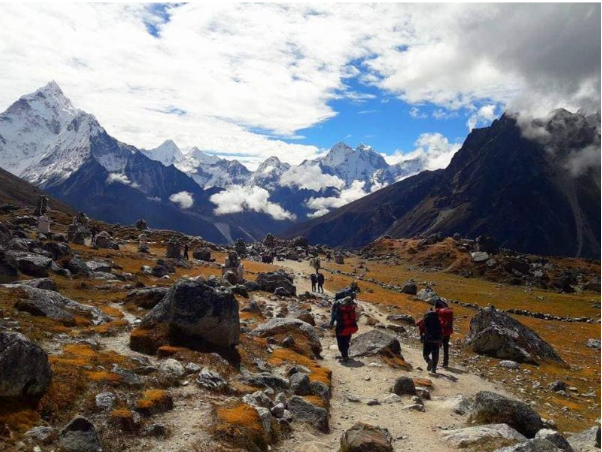Nestled in the heart of the Nepalese Himalayas, the Everest Region is home to some of the world’s most breathtaking trekking routes. Among these, the Hight passes trek in Everest region stands out as one of the most exhilarating and challenging adventures for those seeking to immerse themselves in the raw beauty and grandeur of the mountains. This trek takes you beyond the well-trodden paths of the classic Everest Base Camp route, crossing three high-altitude passes—Renjo La (5,360 m), Cho La (5,420 m), and Kongma La (5,535 m)—offering a unique perspective on the region’s towering peaks, serene valleys, and ancient culture.
Why Choose the High Passes Trek?
The High Passes Trek is more than just a journey through stunning landscapes; it’s an exploration of the Everest region’s cultural and natural diversity. Unlike the standard Everest Base Camp trek, this route introduces trekkers to less-frequented trails and remote villages, providing a deeper connection with the Sherpa culture and an unparalleled sense of solitude.
Key Highlights:
- Panoramic Mountain Views: The trek offers unrivaled views of Everest, Lhotse, Makalu, and Cho Oyu. Each pass provides a unique vantage point to admire these majestic peaks.
- Gokyo Lakes: The turquoise glacial lakes at Gokyo are a major highlight, set against the backdrop of snowy peaks. Climbing Gokyo Ri (5,357 m) offers a stunning panorama, arguably one of the best in the region.
- Cultural Encounters: Visiting monasteries, stupas, and traditional Sherpa villages allows trekkers to witness the rich cultural tapestry of the Himalayas.
- Remote Adventure: Crossing high passes at altitudes above 5,000 meters provides a thrilling sense of adventure and accomplishment.
The Route: An Overview
Starting Point: Lukla
The trek begins with a short but thrilling flight to Lukla, the gateway to the Everest region. From here, trekkers follow the classic route through Phakding and Namche Bazaar, the bustling Sherpa capital.
Renjo La Pass (5,360 m)
The first major challenge, Renjo La, offers breathtaking views of Everest and the Gokyo Lakes. The descent leads to the village of Gokyo, a perfect spot for rest and acclimatization.
Cho La Pass (5,420 m)
Connecting Gokyo with the Everest Base Camp trail, the Cho La Pass involves a steep ascent over rocky terrain and a glacier crossing. The view from the top is spectacular, and the descent into the Khumbu Valley is equally rewarding.
Kongma La Pass (5,535 m)
The highest of the three passes, Kongma La, presents the toughest challenge. The climb is steep, and the altitude demanding, but the panoramic views of the surrounding peaks make every step worth it.
Preparation and Challenges
The High Passes Trek is demanding and requires a good level of physical fitness, proper acclimatization, and mental resilience. The altitude, combined with the rough terrain and unpredictable weather, makes this trek suitable for experienced trekkers.
Essential Preparation Tips:
- Physical Training: Focus on building endurance, strength, and cardiovascular fitness.
- Acclimatization: Plan rest days and ascend gradually to prevent altitude sickness.
- Gear: Invest in quality trekking gear, including layers, sturdy boots, and cold-weather essentials.
- Guides and Porters: Hiring a knowledgeable guide and porter is highly recommended for safety and local insights.
Best Time to Trek
The best seasons for the High Passes Trek are pre-monsoon (March to May) and post-monsoon (September to November). During these periods, the weather is generally stable, and the skies are clear, offering the best views of the mountains.
Conclusion
The High Passes Trek in the Everest Region is a once-in-a-lifetime adventure that combines physical challenge with cultural immersion and breathtaking scenery. For those seeking to push their limits and experience the Himalayas in their most authentic and awe-inspiring form, this trek is the ultimate journey. With proper preparation and a spirit of adventure, the High Passes Trek promises memories and achievements that will last a lifetime.
FAQs
- How long does the High Passes Trek take?
The trek typically takes around 18-21 days, depending on the itinerary and acclimatization schedule. - Is prior trekking experience necessary?
Yes, this trek is challenging and recommended for those with prior high-altitude trekking experience. - What is the difficulty level of the trek?
The trek is considered very challenging due to high altitude, steep ascents, and varying weather conditions. - Do I need permits for the trek?
Yes, you need the Sagarmatha National Park permit and a TIMS (Trekkers’ Information Management System) card. - What are the accommodation options?
Teahouses and lodges are available along the route, providing basic amenities and meals.
Embarking on the High Passes Trek is not just about reaching high altitudes—it’s about discovering the soul of the Himalayas and pushing your limits amidst some of the most stunning landscapes on Earth.
